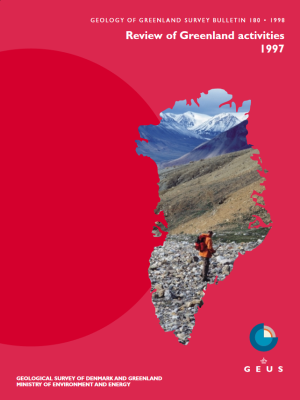Karrat 97: reconnaissance mineral exploration in central West Greenland
DOI:
https://doi.org/10.34194/ggub.v180.5089Abstract
The Karrat 97 project aims at the acquisition of geochemical data from drainage samples and information on mineralisation within a 10 000 km2 area, which stretches from Uummannaq northwards to Prøven (i.e. from 70°30′ to 72°30′ N; Fig. 1). The project area comprises a major Palaeoproterozoic supracrustal unit, the Karrat Group, from which the project takes its name, and which hosts the abandoned Black Angel lead-zinc mine. It is a joint project between the Geological Survey of Denmark and Greenland (GEUS) and the Bureau of Minerals and Petroleum (BMP), Government of Greenland, and wholly funded by the latter. The goal of the project is to win back the interest of the mining industry to the area. The eastern part of the project area is difficult of access due to alpine topography with peaks up to 2300 m, abundant glaciers, and steep-sided, often ice-filled fjords. A somewhat more gentle topography prevails in the western parts of the area. The whole area is underlain by permafrost. Field work was carried out during seven weeks in July–August 1997 by a team of four geologists and four local prospectors. Job-training of the prospectors was an integral purpose of the project, and the manning of the teams was periodically changed so that all four prospectors were introduced to the different topographical and geological terrains in the area as well as to the methods of operation. A chartered 68 foot, 77 tons vessel – M/S Nukik – served as mobile base with accommodation and meals on board; a MD 500 E helicopter with crew chartered through Grønlandsfly A/S participated for one month. The work was carried out from five anchorages, with the helicopter stationed on the adjacent coast. The weather was relatively unstable in the field period, but only five days of work were lost due to bad weather. The field work comprised regional-scale systematic drainage sampling, and detailed mineral exploration at selected sites. The sampling of stream sediment and stream water supplements the geochemical mapping programme of Greenland undertaken jointly by GEUS and BMP (Steenfelt 1993, 1994), the aim of which is to provide systematic, quality controlled geochemical data. The data are used together with geological and geophysical information in the evaluation of the potential for economic mineral resources. Samples were collected by two teams, transported by helicopter or small boats. All ice-free, near-coastal localities were sampled by the boat team, whereas all other localities were sampled by the helicopter team. The results of this work have been reported on by Steenfelt et al. (1998). The detailed mineral exploration was follow-up work on previously outlined indications and anomalies. It was carried out by two teams on daily trips by rubber dinghy or helicopter, or by foot traverses from field camps. This part of the project has been reported on by Thomassen & Lind (1998).
Downloads
Published
Issue
Section
License
This article is distributed under a CC-BY 4.0 licence, permitting free redistribution and reproduction for any purpose, even commercial, provided proper citation of the original work. Author(s) retain copyright over the article contents.


